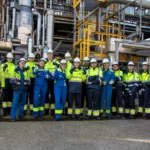
Cefic Executive Director for Climate Change and Energy, Charles-Henri Robert shared his views at European Economic and Social Committee last week, to discuss the role of the chemical industry in reaching energy and climate goals post 2020 .
After the busy election period for the European Parliament, everyone in Brussels is closely following the development of the EU’s overall political strategy for the next five years. This Strategic Agenda is set to be endorsed by national leaders in late June, with climate action expected to be one of EU’s four priority areas. This means European policymakers will be advancing work on the conditions, the incentives and the enabling framework to be put in place to support the transition to a climate-neutral EU.
The European chemical industry intends to actively contribute to Europe’s vision, by being the key innovation provider for many current and future low-carbon solutions. This includes the enabling climate neutral technology for CO2 based chemistry, energy storage and a number of products to improve energy efficiency.
However, it is important to consider when speaking about the development of green solutions and our sector’s emissions reductions at large, that the manufacturing of these enabling chemicals can be resource and energy-intensive. As innovative chemistry is the cornerstone in providing materials for the clean energy transition, it is crucial to understand the chemical industry’s pathways to emissions reductions are closely linked to the decarbonisation of the energy sector. This is because, in the future, we will need more energy to further reduce our emissions.
We are constantly looking at ways to improve our production processes, to lower our carbon footprint and enable further emission reductions down the value chains. In the past 25 years, we have already decreased our emissions by 60%, through product and operational innovations. To ensure this positive development continues, the EU needs a coherent regulatory framework – encompassing climate, energy, industrial, trade and environmental policies.
Ahead of the European Council meeting to validate the five-year plan for Europe, we call on the European leaders to align the EU energy and climate policies with the priority of developing a competitive industrial base in Europe. If for most, the well-recognised energy and climate policy mid-century milestones may seem like a long way off, from the industrial perspective the clock is ticking as we are only two investment cycles away from 2050.
- To find out more on how the Europe’s energy-intensive industries can contribute to the EU long-term GHG goals, click here.










